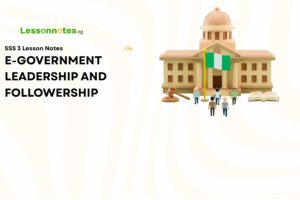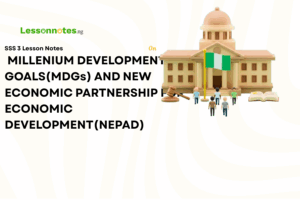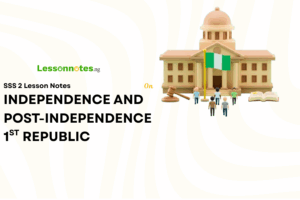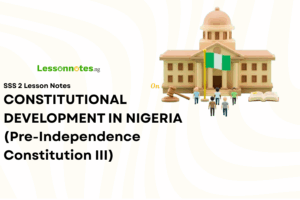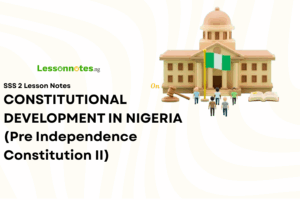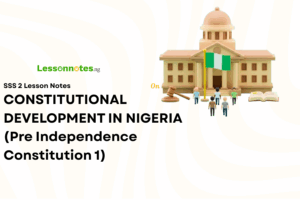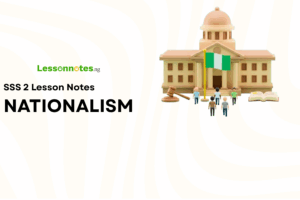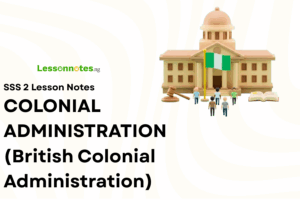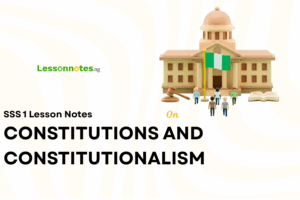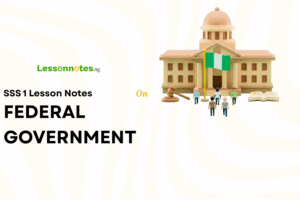Pre colonial Administration SS2 Government Lesson Note
Download Lesson NoteTopic: Pre colonial Administration
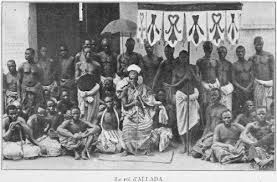
PRE-COLONIAL ADMINISTRATION IN HAUSA/FULANI LAND
Historical background of the Hausa
The Fulani assumed the political leadership of the Habe (Hausa) states in the 19th century after the jihad war led by Othman Dan Fodio. He established the Sokoto caliphate, which was highly politically centralized.
He introduced a new system of selecting rulers known as Emirs to rule the caliphate. Sokoto and Gwandu were made two headquarters for all emirates as each Emir owed allegiance to Othman Dan Fodio and his representatives at Sokoto and Gwandu.
Political Administration
- The Emirate: The caliphate was divided into emirates headed by an Emir possessing almost all powers. He was an authoritarian ruler. He made laws and maintained law and order according to Islamic rules. He was assisted by several advisers. These are:
- The Waziri- he was the head of all the officials.
- The Galadima- He is in charge of the capital.
- The Madawaki- He was the commander of the army.
- The Dogari- He was in charge of the treasury
- SarkinRuwa- the River fishing official.
- SarkinFada- The head of the palace workers.
- SarkinPawa- The head of all butchers.
- Yari- Official in charge of the prisons.
- The legislative organ: The Muslim law known as Sharia was applied throughout the emirate. The law was regarded as the law of God and supreme.
- The Executive organ: The Emir was authoritarian. Though he had a council of adviser, he could accept or reject their advice.
- Judicial organ: The laws were based on sharia laws and the Alkali judges administered them. Some minor cases were passed to the village heads to settle. Criminal and land cases were for the Emir to decide as long as Sharia laws dealt with civil cases.
- District administration: Each emirate was divided into a district headed by an official appointed by the Emir called Hakimi.
Pre-colonial Administration In Igbo Land
The Igbo system had no central authority like the Yoruba and Hausa. Different groups shared power and it involved the general participation of people in governance. They practice a form of direct democracy.
Features Of Igbo Political System
- It was a decentralized and segmented system.
- It was republican. No individual had hereditary rights to political office.
- The system was democratic as there was the principle of equality and social justice.
- There was no centralized power. v. No one was a political ruler.
- Women played a significant role in government through, the Umuada (daughters of the kindred)
Structural Organisation Of The Igbo Political System
- The Village Administration: The Igbo political system was based on the village as a political unit. Each village was made up of families. Each family head held the Ofor title and they all formed the council of elders, which governed the village. The oldest Ofor title holder was referred to as the Okpara and presided over the council of elders meeting where decisions affecting the people are taken. During village meetings, every adult was expected to participate.
- The Executive: The affairs of the village were discussed by the heads (council of elders). Every adult had the power to contribute.
- The Legislature: The villagers made laws themselves. The age grade could make laws, which the elders accepted.
- The Judiciary: Family heads settle disputes between families. Serious cases were referred to the Council of Elders and the Okpara.
- The Age Grade: Some young men belonged to the same age group. They were involved in the administration of the village and performed public duties like clearing parts, roads etc. They maintained security and helped in the implementation of policies made by the Council of Elders.
- The Ozor Titleholders: Some wealthy and influential men took the Ozor title, which was very expensive. The society respected such men and they could join the council of elders to debate on issues affecting the people.
- Women’s Association: They participated in settling disputes as they served as a powerful pressure group. They socialized with their young ones by inculcating in them good morals, political values and norms. They stood against corruption and oppression.
Pre-colonial Political System In Yoruba Land
Oyo was a very large empire divided into different provinces. The system of government in the Old Oyo Empire was like most other kingdoms and empires that existed in Africa. It was monarchical and was headed by a king called Alafin.
Features of Yoruba Pre-colonial Political System
- The size of the political system was a very large one.
- The system was a constitutional monarch, the system was decentralized, and the Oba was not an autocratic ruler.
- There was a system of checks and balances so that the Oba did not abuse the power.
- The Oba only ratified the decisions taken by the chiefs.
- There was no system of taxation.
Political Administration
- Political head: The Alafin was the political head of the empire. He was chosen by the Oyomesi and seven hereditary king-makers of the empire. It was claimed that the Alafin only appeared to the public three times a year during historic festivals. The administration of the empire involved the Alafin assisted by the Aremo, the Bashorun, Oyomesi and others. The Bashorun (prime minister) and the Oyomesi played a key role in the administration.
- The Aremo: He is the eldest son of the Alafin but cannot succeed the father at his demise. He only assisted the Alafin in the administration of the empire.
- The Oyomesi: They were the seven hereditary kingmakers in the empire headed by the Bashorun. Their duty was to install a new Alafin when the ruling one died or to remove the Alafin. They also assisted Alafin in the administration of the empire.
- Provincial Governors: (Bale or Oba) Each province was ruled by Ajele or Oba. They were responsible for the collection of tributes and the payment of homage to Alafin.
- The Army: The Aare-ona kakapo was the head of the army. It was claimed that if the army suffered a defeat, the kankafo would commit suicide.
- The Ogboni Society: This was a secret society made up of prominent diviners headed by the Oluwo. They were the third organ of government in the Old Oyo Empire. They checked the excesses of the Oyomesi such as their rejection of an Alafin. They performed judicial functions. They maintained and preserved the cultural duties of the people.
- The three Eunuchs: They were also involved in the administration of the empire. They included.
- The Osi Efa- He was in charge of political affairs and customary, he had to die with the Alafin.
- The Oni Efa- for the judiciary
- The Otun Efa- performs religious duties for the Alafin.
- The Empty Calabash: If the Alafin begins to act unconstitutionally, the Oyomesi could authorize the Bashorun to send an empty Calabash to the king which signifies his rejection. The Alafin was expected to commit suicide afterwards.
- Kingship: The ascension to the throne of Alafin was not hereditary but the Oyomesi were free to choose a new ruler from the royal families.
FUNCTIONS OF THE TRADITIONAL RULERS IN THE PRE-COLONIAL POLITICAL SYSTEM
- They acted as the supreme rulers in their various communities.
- They performed legislative functions of law-making in their communities.
- They ensured the defence of their communities.
- They performed religious functions as high priests of some religious cults.
- They were the heads of administration in their various communities.
- They safeguarded the lives of people in their communities.
- They were involved in the sharing of communal wealth.
- They served as political symbols of unity.
- They were involved in the maintenance of law and order in the communities.
- They planned for the progress and development of their communities.
FUNCTIONS AND POWERS OF THE COUNCIL OF ELDERS
- The council advised the paramount chiefs.
- The council of elders was responsible for the maintenance of law and order.
- The council acted as a decision-making body.
- It performed religious functions.
- The council helped to install and depose paramount chiefs.
- The council checked the activities of the paramount chiefs.
- The council decided whether the community would go to war or not.
FUNCTIONS OF SECRET SOCIETIES
- They helped to enforce law and order.
- They performed both military and police functions.
- They served as a link between the members of the communities and their ancestors.
- They protected their members.
- They helped to educate their members and other members of the community.
- They performed rituals to drive away evil spirits.
- They acted as agents of socialization.
FUNCTIONS OF AGE GRADE
- The prosecution of warfare was done by the age grade.
- They undertook social labour like the construction of roads, bridges etc.
- They performed socialization functions.
- They performed ceremonial functions during important occasions in their communities.
- They helped to defend their communities against both internal and external aggression.
- They checked the wrong use of powers by permanent chiefs.



